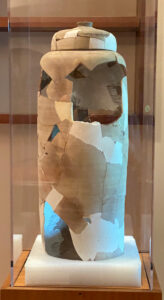In late summer, Longyear Museum took possession of a rare antiquity—a reconstructed 2,000-year-old jar from the famed caves of Qumran, where the Dead Sea Scrolls were first discovered in 1947.1
Now on display in the Museum’s Daycroft Library, the jar was donated to Longyear by longtime supporters of the Endowment for Biblical Research (EBR), Boston. The EBR supporters’ purchase and subsequent gift of the artifact to Longyear was intended to make the jar and its history more readily accessible to the public.

“This is a fascinating addition to Longyear’s institutional history,” comments Longyear’s Director of Collections Deb Wold. “It underscores the research and collecting subjects in which Museum founder Mary Beecher Longyear was deeply interested—namely, Bible history and the life of Mary Baker Eddy.” (Originally named the Zion Research Foundation, EBR was founded in 1920 by Mrs. Longyear to research “biblical origins” and to support Bible study, research, and scholarship. )
Written primarily in Hebrew (with a few in Aramaic and Greek), the Dead Sea Scrolls date from the third century B.C.E. to the first century C.E. and were excavated mainly from 11 caves in the area. The majority of the scrolls—as well as the delicate jars that contained them—were found only as fragments of parchment or sherds of pottery. From these remnants, scholars have reconstructed more than 900 manuscripts, which include some 200 copies of books of the Hebrew Bible, providing the earliest evidence of those biblical texts.2
During the early years of the discovery of the Qumran caves and their contents, EBR funded multiple archeological digs and disseminated information about finds. In January 1950, EBR hosted what was described as the “first showing in America of Dead Sea Scroll #4.” The owner of that scroll, the former archbishop of Jerusalem and Jordan, was guest of honor at the event.3 Subsequently, EBR helped fund specialized color photography of the Scrolls so they could be studied by future generations. The organization purchased this jar (found in Qumran Cave #1) in 1951 from the Government of Jordan through the Palestine Archeological Museum in Jerusalem. The jar’s arrival by airplane at Logan Airport was reported in the media.
This time around, when making its journey to Longyear in August 2024, the jar was transported (v-e-r-y slowly) by a skilled fine-arts moving company on a truck with special suspension—and under the keen eye of antiquities conservator Valentine Talland as well as Deb and other members of the Longyear collections team. The final placement of this fragile piece of history in its new home was greeted with a collective sigh of relief and smiles!
